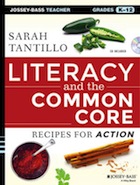Skimming: The Overlooked Close Reading Skill

Although it might seem as though skimming is the opposite of close reading (and in a way, it is), it is also a crucial skill for pulling information out of a text.
One day when I was sitting in a seventh-grade classroom, the teacher asked her students to describe Ponyboy in S.E. Hinton’s The Outsiders. A boy named Julio raised his hand and said that Ponyboy was “frustrated.”
“Frustrated? OK. How do you know?” the teacher said.
Julio stared at her helplessly for a moment, then shrugged and said, “I just know.”
“Where in this chapter—what in this chapter—gave you the idea that he was frustrated, Julio?” She added, “Look in your book. Everybody, look in your book in this chapter. Where in the chapter can you find evidence that Ponyboy was frustrated? Find me some evidence. I’ll give you three minutes.”
I watched the students. They dutifully opened their books and bowed their heads as though directed to pray. Indeed, from the furtive glances that several students cast at Julio, it seemed that they were praying he would find the answer quickly. A few others seemed to be boring holes into the pages with their eyes, trying to read every word in the chapter.
Aha, I thought. They do not know how to skim.
I asked the teacher if I could call timeout and ask the students a question. She nodded.
“When you’re looking for evidence about a character in the text,” I said, “what strategy or strategies are you using?”
One girl answered, “We’re re-reading.”
“OK,” I said, “but this chapter is twelve pages long and you only have three minutes. I’m a very fast reader, but even I couldn’t read every word!” I paused, and I could see the students nodding with relief (no doubt thinking, See, she thinks our teacher is crazy, too. Nobody can re-read a whole chapter in three minutes!). Then I asked, “So what do you do?”
“You look for key words,” Julio offered.
“OK, good idea. But how do you know which words are ‘key’? Let’s think about this. We’re detectives, and we’re looking for clues that Ponyboy is frustrated. We can’t read every word, so we have to skim. So, number one, obviously, we’re looking for his name, right? Then what do we look for?”
A girl raised her hand and said hesitantly, “D.DAT?” She was referring to something her teacher had taught recently: an acronym which stands for “direct Description and indirect characterization through Dialogue, Action, and Thought” (see below).
“Exactly! Please explain.”
“We could try to see if Ponyboy was described as frustrated or if he said something, did something, or thought something that made it seem like he was.”
“Terrific! So let’s try this strategy….”
|
Characterization Methods: “D.DAT” D.DAT is a simple mnemonic device to help readers remember how writers develop characters.DIRECT characterization: Description: INDIRECT characterization: Dialogue: Example: “I want to save the whales,” she explained. (We can infer that she cares about animals and maybe that she is idealistic.) Actions: Example: The young man studied every night and earned straight A’s in high school. (We can infer that he is hardworking and perseverant.) Thoughts: Example: The girl wondered if the boy would ask her to dance. (We can infer that she has a crush on him.) NOTE: This table is excerpted from a handout called “Characterization Methods: DDAT,” which appears on the TLC “Analyzing Literature” page. |
Other types of skimming
The students in this case used D.DAT and found some evidence to support Julio’s argument. Going forward, depending on the genre of the text and the nature of the question they wanted to answer, they would need to use different approaches to skimming. For example, if they were reading a persuasive passage and were asked, “What are the writer’s main arguments?” then they would need to know how to scan for the thesis and topic sentences.
This episode clarified three points for me:
1) We need to teach students how to skim! Ironically, we often overlook this skill.
2) Skimming is not easy if you don’t have any strategies for how to do it.
3) Students can be taught specific skimming strategies, but they also need to practice figuring out which strategies are most appropriate to use in any given situation.

Sarah Tantillo is a literacy consultant who taught secondary school English and Humanities in both suburban and urban public schools for fourteen years, including seven years at the high-performing North Star Academy Charter School of Newark. She’s the author of The Literacy Cookbook and offers professional development help at her blog of the same name.


































Thanks for a very helpful article. I teach ELLs, and they respond quite well to mnemonic devices. I will most certainly D.DAT tomorrow and beyond!
Good method for developing skimming skills. It is not only the requirement of English literature but also needed for other texts such as science.